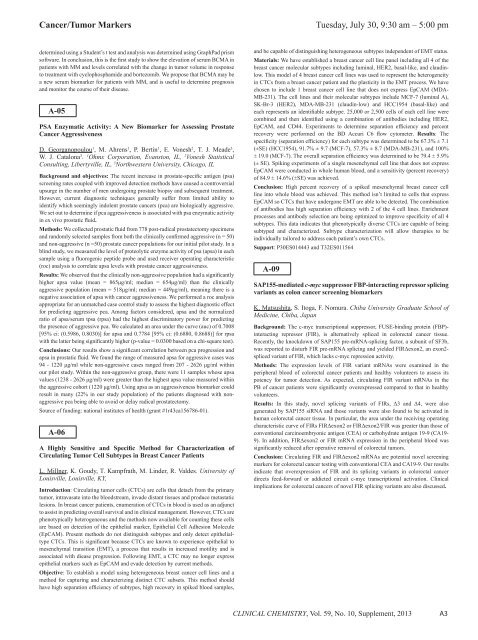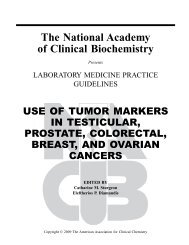Abstracts of the Scientific Posters, 2013 AACC Annual Meeting ...
Abstracts of the Scientific Posters, 2013 AACC Annual Meeting ...
Abstracts of the Scientific Posters, 2013 AACC Annual Meeting ...
Create successful ePaper yourself
Turn your PDF publications into a flip-book with our unique Google optimized e-Paper software.
Cancer/Tumor Markers<br />
Tuesday, July 30, 9:30 am – 5:00 pm<br />
determined using a Student’s t test and analysis was determined using GraphPad prism<br />
s<strong>of</strong>tware. In conclusion, this is <strong>the</strong> first study to show <strong>the</strong> elevation <strong>of</strong> serum BCMA in<br />
patients with MM and levels correlated with <strong>the</strong> change in tumor volume in response<br />
to treatment with cyclophosphamide and bortezomib. We propose that BCMA may be<br />
a new serum biomarker for patients with MM, and is useful to determine prognosis<br />
and monitor <strong>the</strong> course <strong>of</strong> <strong>the</strong>ir disease.<br />
A-05<br />
PSA Enzymatic Activity: A New Biomarker for Assessing Prostate<br />
Cancer Aggressiveness<br />
D. Georganopoulou 1 , M. Ahrens 1 , P. Bertin 1 , E. Vonesh 2 , T. J. Meade 3 ,<br />
W. J. Catalona 3 . 1 Ohmx Corporation, Evanston, IL, 2 Vonesh Statistical<br />
Consulting, Libertyville, IL, 3 Northwestern University, Chicago, IL<br />
Background and objectives: The recent increase in prostate-specific antigen (psa)<br />
screening rates coupled with improved detection methods have caused a controversial<br />
upsurge in <strong>the</strong> number <strong>of</strong> men undergoing prostate biopsy and subsequent treatment.<br />
However, current diagnostic techniques generally suffer from limited ability to<br />
identify which seemingly indolent prostate cancers (pca) are biologically aggressive.<br />
We set out to determine if pca aggressiveness is associated with psa enzymatic activity<br />
in ex vivo prostatic fluid.<br />
Methods: We collected prostatic fluid from 778 post-radical prostatectomy specimens<br />
and randomly selected samples from both <strong>the</strong> clinically confirmed aggressive (n = 50)<br />
and non-aggressive (n =50) prostate cancer populations for our initial pilot study. In a<br />
blind study, we measured <strong>the</strong> level <strong>of</strong> proteolytic enzyme activity <strong>of</strong> psa (apsa) in each<br />
sample using a fluorogenic peptide probe and used receiver operating characteristic<br />
(roc) analysis to correlate apsa levels with prostate cancer aggressiveness.<br />
Results: We observed that <strong>the</strong> clinically non-aggressive population had a significantly<br />
higher apsa value (mean = 865μg/ml; median = 654μg/ml) than <strong>the</strong> clinically<br />
aggressive population (mean = 518μg/ml; median = 449μg/ml), meaning <strong>the</strong>re is a<br />
negative association <strong>of</strong> apsa with cancer aggressiveness. We performed a roc analysis<br />
appropriate for an unmatched case control study to assess <strong>the</strong> highest diagnostic effect<br />
for predicting aggressive pca. Among factors considered, apsa and <strong>the</strong> normalized<br />
ratio <strong>of</strong> apsa/serum tpsa (rpsa) had <strong>the</strong> highest discriminatory power for predicting<br />
<strong>the</strong> presence <strong>of</strong> aggressive pca. We calculated an area under <strong>the</strong> curve (auc) <strong>of</strong> 0.7008<br />
[95% ci: (0.5986, 0.8030)] for apsa and 0.7784 [95% ci: (0.6880, 0.8688)] for rpsa<br />
with <strong>the</strong> latter being significantly higher (p-value = 0.0300 based on a chi-square test).<br />
Conclusions: Our results show a significant correlation between pca progression and<br />
apsa in prostatic fluid. We found <strong>the</strong> range <strong>of</strong> measured apsa for aggressive cases was<br />
94 - 1220 μg/ml while non-aggressive cases ranged from 207 - 2626 μg/ml within<br />
our pilot study. Within <strong>the</strong> non-aggressive group, <strong>the</strong>re were 11 samples whose apsa<br />
values (1238 - 2626 μg/ml) were greater than <strong>the</strong> highest apsa value measured within<br />
<strong>the</strong> aggressive cohort (1220 μg/ml). Using apsa as an aggressiveness biomarker could<br />
result in many (22% in our study population) <strong>of</strong> <strong>the</strong> patients diagnosed with nonaggressive<br />
pca being able to avoid or delay radical prostatectomy.<br />
Source <strong>of</strong> funding: national institutes <strong>of</strong> health (grant #1r43ca156786-01).<br />
A-06<br />
A Highly Sensitive and Specific Method for Characterization <strong>of</strong><br />
Circulating Tumor Cell Subtypes in Breast Cancer Patients<br />
L. Millner, K. Goudy, T. Kampfrath, M. Linder, R. Valdes. University <strong>of</strong><br />
Louisville, Louisville, KY,<br />
Introduction: Circulating tumor cells (CTCs) are cells that detach from <strong>the</strong> primary<br />
tumor, intravasate into <strong>the</strong> bloodstream, invade distant tissues and produce metastatic<br />
lesions. In breast cancer patients, enumeration <strong>of</strong> CTCs in blood is used as an adjunct<br />
to assist in predicting overall survival and in clinical management. However, CTCs are<br />
phenotypically heterogeneous and <strong>the</strong> methods now available for counting <strong>the</strong>se cells<br />
are based on detection <strong>of</strong> <strong>the</strong> epi<strong>the</strong>lial marker, Epi<strong>the</strong>lial Cell Adhesion Molecule<br />
(EpCAM). Present methods do not distinguish subtypes and only detect epi<strong>the</strong>lialtype<br />
CTCs. This is significant because CTCs are known to experience epi<strong>the</strong>lial to<br />
mesenchymal transition (EMT), a process that results in increased motility and is<br />
associated with diease progression. Following EMT, a CTC may no longer express<br />
epi<strong>the</strong>lial markers such as EpCAM and evade detection by current methods.<br />
Objective: To establish a model using heterogeneous breast cancer cell lines and a<br />
method for capturing and characterizing distinct CTC subsets. This method should<br />
have high separation efficiency <strong>of</strong> subtypes, high recovery in spiked blood samples,<br />
and be capable <strong>of</strong> distinguishing heterogeneous subtypes independent <strong>of</strong> EMT status.<br />
Materials: We have established a breast cancer cell line panel including all 4 <strong>of</strong> <strong>the</strong><br />
breast cancer molecular subtypes including luminal, HER2, basal-like, and claudinlow.<br />
This model <strong>of</strong> 4 breast cancer cell lines was used to represent <strong>the</strong> heterogeneity<br />
in CTCs from a breast cancer patient and <strong>the</strong> plasticity in <strong>the</strong> EMT process. We have<br />
chosen to include 1 breast cancer cell line that does not express EpCAM (MDA-<br />
MB-231). The cell lines and <strong>the</strong>ir molecular subtypes include MCF-7 (luminal A),<br />
SK-Br-3 (HER2), MDA-MB-231 (claudin-low) and HCC1954 (basal-like) and<br />
each represents an identifiable subtype. 25,000 or 2,500 cells <strong>of</strong> each cell line were<br />
combined and <strong>the</strong>n identified using a combination <strong>of</strong> antibodies including HER2,<br />
EpCAM, and CD44. Experiments to determine separation efficiency and percent<br />
recovery were performed on <strong>the</strong> BD Accuri C6 flow cytometer. Results: The<br />
specificity (separation efficiency) for each subtype was determined to be 67.3% ± 7.1<br />
(±SE) (HCC1954), 91.7% ± 9.7 (MCF-7), 57.3% ± 8.7 (MDA-MB-231), and 100%<br />
± 19.0 (MCF-7). The overall separation efficiency was determined to be 79.4 ± 5.9%<br />
(± SE). Spiking experiments <strong>of</strong> a single mesenchymal cell line that does not express<br />
EpCAM were conducted in whole human blood, and a sensitivity (percent recovery)<br />
<strong>of</strong> 84.9 ± 14.6% (±SE) was achieved.<br />
Conclusion: High percent recovery <strong>of</strong> a spiked mesenchymal breast cancer cell<br />
line into whole blood was achieved. This method isn’t limited to cells that express<br />
EpCAM so CTCs that have undergone EMT are able to be detected. The combination<br />
<strong>of</strong> antibodies has high separation efficiency with 2 <strong>of</strong> <strong>the</strong> 4 cell lines. Enrichment<br />
processes and antibody selection are being optimized to improve specificity <strong>of</strong> all 4<br />
subtypes. This data indicates that phenotypically diverse CTCs are capable <strong>of</strong> being<br />
subtyped and characterized. Subtype characterization will allow <strong>the</strong>rapies to be<br />
individually tailored to address each patient’s own CTCs.<br />
Support: P30ES014443 and T32ES011564<br />
A-09<br />
SAP155-mediated c-myc suppressor FBP-interacting repressor splicing<br />
variants as colon cancer screening biomarkers<br />
K. Matsushita, S. Itoga, F. Nomura. Chiba University Graduate School <strong>of</strong><br />
Medicine, Chiba, Japan<br />
Background: The c-myc transcriptional suppressor, FUSE-binding protein (FBP)-<br />
interacting repressor (FIR), is alternatively spliced in colorectal cancer tissue.<br />
Recently, <strong>the</strong> knockdown <strong>of</strong> SAP155 pre-mRNA-splicing factor, a subunit <strong>of</strong> SF3b,<br />
was reported to disturb FIR pre-mRNA splicing and yielded FIRΔexon2, an exon2-<br />
spliced variant <strong>of</strong> FIR, which lacks c-myc repression activity.<br />
Methods: The expression levels <strong>of</strong> FIR variant mRNAs were examined in <strong>the</strong><br />
peripheral blood <strong>of</strong> colorectal cancer patients and healthy volunteers to assess its<br />
potency for tumor detection. As expected, circulating FIR variant mRNAs in <strong>the</strong><br />
PB <strong>of</strong> cancer patients were significantly overexpressed compared to that in healthy<br />
volunteers.<br />
Results: In this study, novel splicing variants <strong>of</strong> FIRs, Δ3 and Δ4, were also<br />
generated by SAP155 siRNA and those variants were also found to be activated in<br />
human colorectal cancer tissue. In particular, <strong>the</strong> area under <strong>the</strong> receiving operating<br />
characteristic curve <strong>of</strong> FIRs FIRΔexon2 or FIRΔexon2/FIR was greater than those <strong>of</strong><br />
conventional carcinoembryonic antigen (CEA) or carbohydrate antigen 19-9 (CA19-<br />
9). In addition, FIRΔexon2 or FIR mRNA expression in <strong>the</strong> peripheral blood was<br />
significantly reduced after operative removal <strong>of</strong> colorectal tumors.<br />
Conclusion: Circulating FIR and FIRΔexon2 mRNAs are potential novel screening<br />
markers for colorectal cancer testing with conventional CEA and CA19-9. Our results<br />
indicate that overexpression <strong>of</strong> FIR and its splicing variants in colorectal cancer<br />
directs feed-forward or addicted circuit c-myc transcriptional activation. Clinical<br />
implications for colorectal cancers <strong>of</strong> novel FIR splicing variants are also discussed.<br />
CLINICAL CHEMISTRY, Vol. 59, No. 10, Supplement, <strong>2013</strong><br />
A3
















